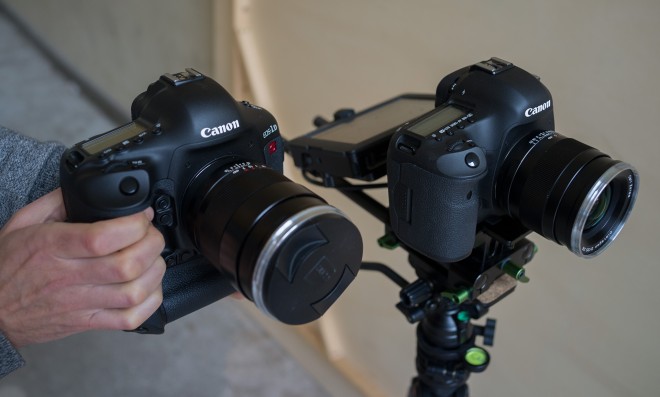
This test was conducted jointly with my good friend and neighbour Rudi at Slashcam – you can read his take on it in German / in English.
In the battle of the 1080p cameras, the game has changed. Here’s how the 5D Mark III in raw recording mode compares to the best 1080p output from the Canon C300 and 1D C.
The Canon C300 is a very good albeit highly priced $15,000 HD camera, producing an ultra clean and detailed image by oversampling from the same 4K sensor as the C500.
It is the current benchmark, so interesting to see how close the 5D Mark III raw gets in 1080p.
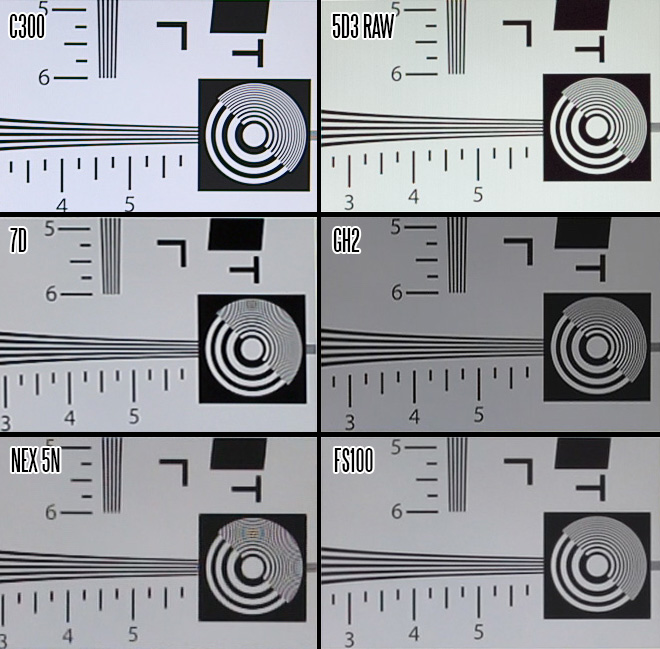
Pay attention to the circles!
12 o’clock shows vertical resolution, 3 o’clock shows horizontal. All the lines should be distinct. The extremely fine patterns also test for moire and false colour, as evidenced on the NEX 5N and 7D shots.
The 5D Mark III raw is impressive and compares closely to the C300, but has a few more tricks which elevate it.
The comparison above is shot at 1080p but with an anamorphic lens to correct the 3:2 aspect ratio, the 5D Mark III goes to 1280 lines from a full frame sensor, even higher in 1:1 crop mode. It uses a larger sensor than the C300 and the footage is more gradable because it is raw.
In 1:1 crop mode it gives you a lossless 1080p crop sensor mode, or higher resolutions and in this mode the camera is even more detailed and even cleaner.
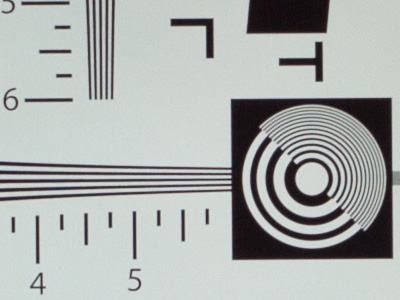
Above: 1:1 crop mode in 1080p, 5D Mark III raw
Due to the way the crop mode framing works in the current Magic Lantern build we couldn’t do a final 100% perfect chart test for the 1:1 mode so please treat that last image as a work in progress not a final result!
The Panasonic GH2 is third best on this test, certainly closer to the C300 and 5D Mark III raw than the other cameras, which is astonishing considering the price difference.
The 5D Mark III is slightly cleaner than the GH2, with less aliasing, especially horizontally but it’s still a good result for the GH2.
The Sony FS100 seems to have a soft default output and a strong anti-aliasing filter. The 7D and NEX 5N are a big step down with plenty of moire.
To summarise, I’d put the cameras in order of resolution at 1080p as follows:
- Canon C300
- Canon 5D Mark III Raw (1080p)
- Panasonic GH2
- Sony FS100
- Canon 7D
- Sony NEX 5N / VG20
I’d tentatively say the 5D Mark III in raw 1:1 crop mode has the Canon C300 beaten for resolution, but more development is needed with Magic Lantern before we can say for sure with any finality. For all I know they could have a Super 35mm 4K crop working eventually, it’s too premature to judge the final resolution of the crop mode. Exciting times ahead!
Canon 1D C
The 1D C uses a 1:1 crop (at APS-H) to achieve it’s 4K image, a huge 4096 x 2160. The aspect ratio is slightly narrower than 16:9 and the sensor area used quite a bit less than the 5D Mark III raw in full frame mode.
When you scale 4K on the 1D C down to 1080p you get cinema standard 2K (2048 x 1080) rather than the full HD TV standard 1920 x 1080.
Here’s how the field of view differs between the 5D Mark III in raw (full frame) and the 1D C in 4K MJPEG mode (APS-H). Shot with a Zeiss 25mm F2.0 Distagon.
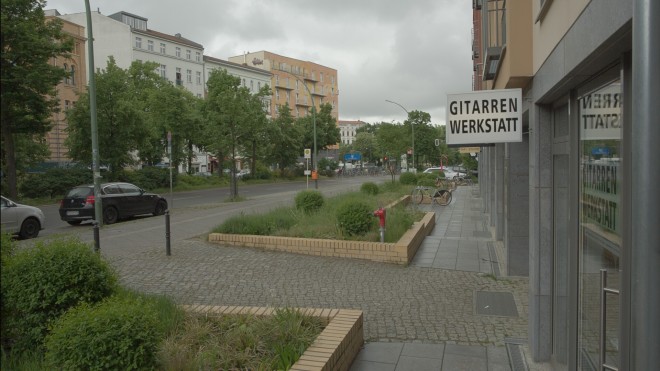

You have to bear this in mind and how it affects your lenses. The 1.3x crop of the 1D C makes the Zeiss 25mm a rather less exciting 32mm, and the crop vertically is even more due to the narrower aspect ratio compared to 16:9 (or especially 3:2) on the 5D Mark III in raw.
The 1D C and 1D X can do a full frame 1080p image too of course, but the 5D Mark III raw is a lot nicer and more detailed for that.
So 4K is what the 1D C is all about for me.
We shot in 4K Canon LOG, 1080p raw on the 5D Mark III and noticed a few interesting pros and cons for both cameras…
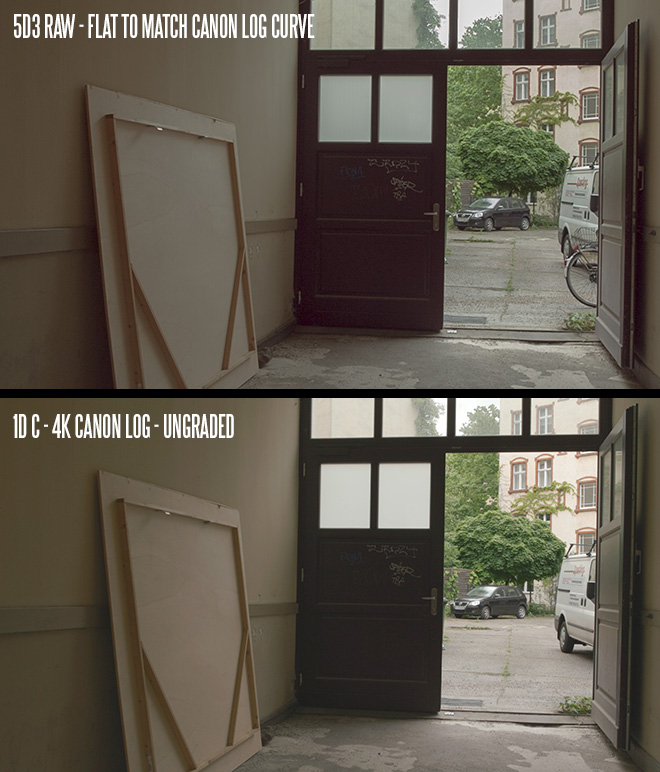
This example is not a proper dynamic range test as we didn’t have much time for the actual shoot setup, but upon spending an hour experimenting and grading the DNG to match Canon LOG I felt dynamic range was about 1 stop more on the 5D Mark III.
Raw also has a much more film-like gradation in the shadows and with skin tones than 4K MJPEG on the 1D C, without the odd colours and banding the 1D C throws up.
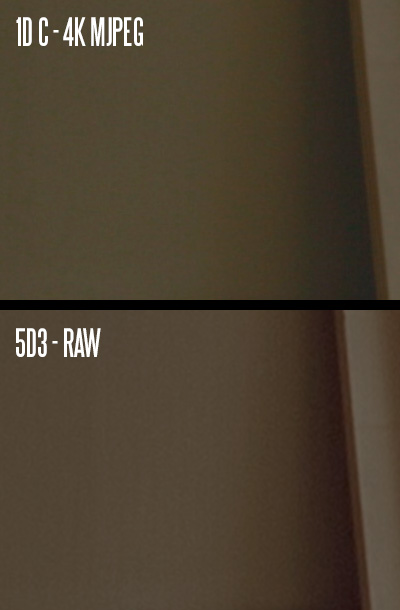
At ISO 800 the blacks are nice and clean in Canon LOG on the 1D C, because the camera applies noise reduction to the raw sensor output.
I did the same to the 5D Mark III raw DNG to see how close I could get it to the 1D C and indeed the black levels can compete…
This is an extreme push of the blackest BMW blacks, bearing in mind the camera was exposed for the sky! Magic Lantern offers raw zebras and these were extremely accurate. There was more noise in the 5D Mark III blacks but the noise reduction got rid of it without reducing resolution.
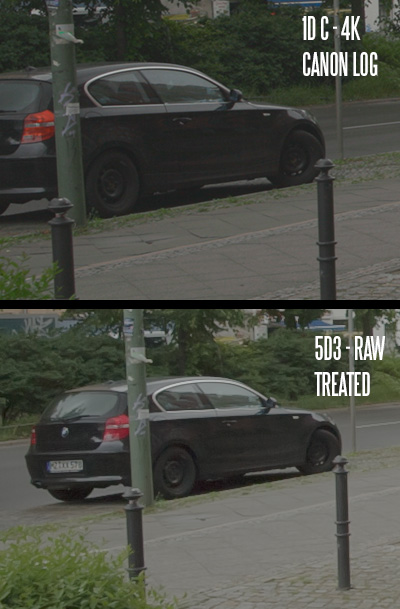
What about upscaling to 4K?
The optimal way to do this is to shoot 1920 x 1280 raw on the 5D Mark III with an anamorphic lens utilising the whole height of the 3:2 sensor. Then keep the horizontal resolution at the maximum 1280 and upscale the width to 2.5K.
Less optimal is to simply scale the 1920 x 1080 raw to 4K, matching both the horizontal and vertical resolution of the 1D C as closely as possible.
Upscaling to 2160 vertical to match the 1D C gives you 16:9 standard 4K at 3840 x 2160. The 1D C 4K is cinema standard 4096 x 2160. Here’s a 1:1 crop of both.
At infinity focus:
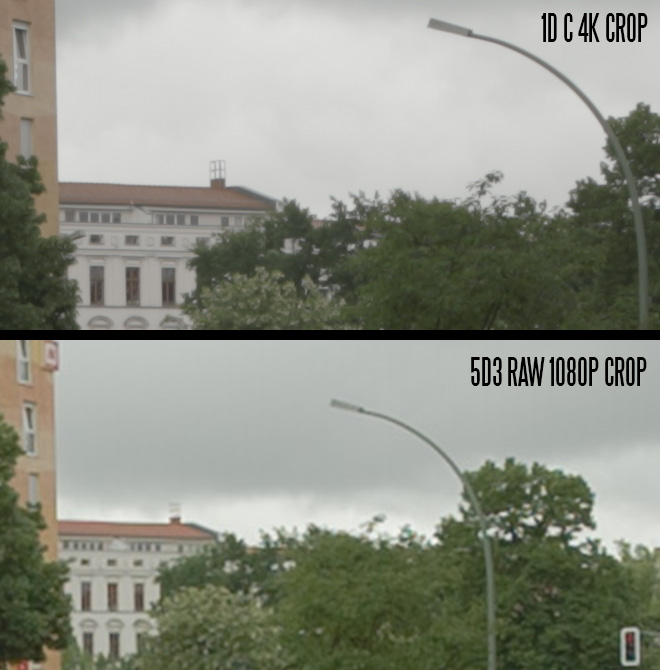
At near focus:
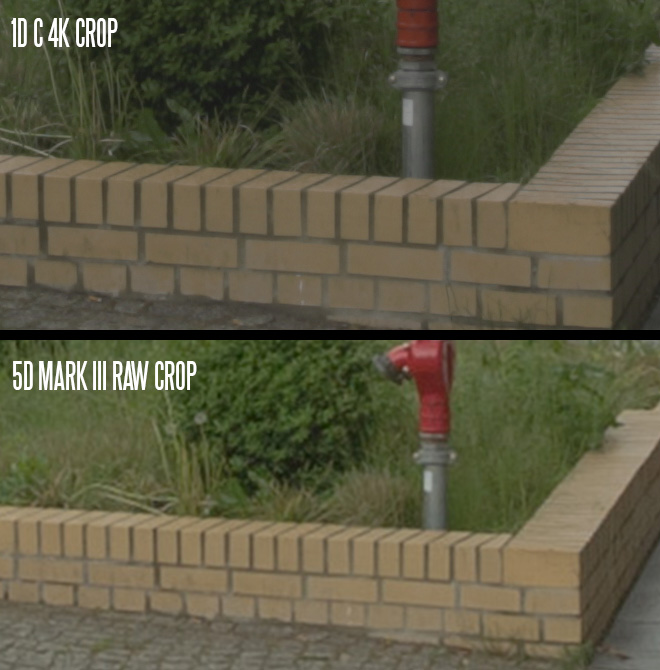
In reality the difference is less than these crops show.
The 1D C’s crop factor of 1.3x is helping it result more detail, especially at infinity as the effective focal length changes from 25mm to 32mm. The difference is less noticeable at near focus but still significant when viewing 1:1 crops like this. It will be less noticeable projected at 4K when the viewing distances aren’t enough to determine individual pixels at the one one level and the image is moving.
Summary
I feel the 5D Mark III in raw is both amazing and feature packed relative even to the professional $12k and $15k C-series offerings let alone other DSLRs. It is a dream for anamorphic shooters, offering very clean 2.5K anamorphic images with a 1280p vertical resolution. Various shooting aspect ratios such as 3:2 and 4:3 are not offered on the C-series cameras. To utilise the full height of a 3:2 full frame sensor is a genuinely new feature, as even the factory 5D Mark III crops the full sensor to 16:9 with the standard video mode. The Nikon D800 also crops the full frame sensor. With anamorphic on the 5D Mark III with raw you have a larger sensor recording area than any other DSLR on the market, and considerably different to Super 35mm, APS-C or the 1D C’s APS-H 4K MJPEG.
The 1D C is of course top dog for resolution but the image cannot be graded with the freedom of raw, even from Canon Log. Colour and gradation, especially when it comes to skin-tones are better on the 5D Mark III with raw.
The cleanness of the full frame 1080p mode is also excellent on the 5D Mark III in raw, ahead of any other DSLR on the market and so close to the $15,000 Canon C300 that in the real world it makes no difference. Only on the most demanding test chart could I tell.
These are astonishingly exciting times for 5D Mark III owners.


